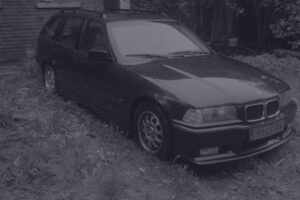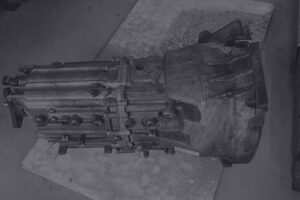So, you have a hole in the metal and have no welding machine @ hand at the moment? Had a same issue with my 4th car. Sadly, older station wagons tends to have a lot of problems with rear hatches. In this case thanks to the poor window wiper shaft isolation against metal edges metal was quickly replaced with rust & air…..

Back at this time I still had no knowledge how to weld and didn’t had a pleasure to own a welding machine. So after quick research I was advised to use aluminum wire mesh witch is glued to the rear side of hole to support filler.
So first remove all details on the way and (in this case window wiper with glass) and using twisted wire wheel on grinder try to remove as much rust as possible. If you are using pneumatic tools you can also use standard wire wheel but keep in mind that cheaper wheel you are using, more wires it will starts to throw at you, so good face protection is mandatory in this case!! Of course you can also use standard wire wheel on grinder but wire shower will be quite heavy in most cases so I try to avoid those thing in most cases.

So, after you have removed as much rust as possible it is time to start adding back missing materia. In case if there was some unreachable rust left after cleaning I tend to use some rust converters like Presto Umwandler witch is wonderful product and work very well!
In my chase I just used some etch primer for beginning and glued wire mesh on top:

To be honest this is not correct way to do things! It is not recommended to put body filler on top of self etch primer! In this case the wire mesh should had glued first, then body filler and after this you can proceed with etch primer!! Self etch primer is widely use @ paint workshops who are painting cars on daily basis because lower cost but if you are just a small workshop etc it is always better to go with epoxy primer!. Epoxy is quite fool proof- you can put filler on top of that and also you don’t have to cover it with 2k primer so quickly. For etch it is quite critical to lay 2k primer on top of it as soon as possible to avoid further corrosion- had a case when after cleaning the surface, I just covered rust spots with etch and left them uncovered for month witch ended with new fresh rust stains arising under self etch primer.
So, to make its simple always use epoxy primer, then glue wire meh with chemical metal on back side of hole (if rear side is unreachable then hammer the edges of holes little bit inside to make a socket for wire mesh edges). Fill the smaller holes with glass fiber body filler, sand it down with grit 80 sand paper. After that apply polyester filler and sand it with grit 180. Repeat the process until you have reached desired contour of surface. Keep in mind that all holes and scratches what are felt with finger wont be filled with 2k primer so take some extra time to apply more body filler to those places! If you are planning to paint the whole detail then it is good time prep the surface with light gray scotch brite witch is aprox grit 600-800.
So, now you have reached the moment when surface is finally ready for primer. Before that get some silicon remover and wipe the surface with microfiber rag until surface is nice and clean. Then throw another 2-3 layers of epoxy on top of that filler to seal it proper and you can proceed to 2K primer. Apply another 2 to 3 layers of that, let it also dry completely and wet sand the surface with grit 600. Surface should be nice and smooth now without any rough spots etc. Clean the surface again with previously mentioned solution until there is no dust! Paint the detail by applying 2-3 layers of paint and do the same with clear coat if u are dealing with metallic paint.
Steps by points:
- prep the area by removing items on the way
- remove the rust with wire brush or other similar method
- if there is some unreachable rust, then use rust converter
- clean surface with silicon remover
- apply 2-3 layers of epoxy primer
- glue the aluminum wire mesh with chemical metal on place
- apply glass fiber body filler
- sand it with with grit 80 sandpaper
- good idea to blow of the dust with air
- clean surface with silicon remover
- apply polyester filler
- sand it with grit 180
- mat other paintable surfaces with light gray scotch bite
- clean the surface
- apply another 2-3 layers of epoxy
- apply 2-3 layers of 2k primer
- wet sand it gently with grit 600
- clean the surface
- apply paint
- apply clear coat if dealing with metallic paint
I hope that you can find some help from this post! This is definitely not rule of thumb to follow and missing some small bits but maybe it can give you some rough vision how much steps you have to take to make it happen! Hopefully I have time in the future to do the complete write up!
Thank you for the reading!




